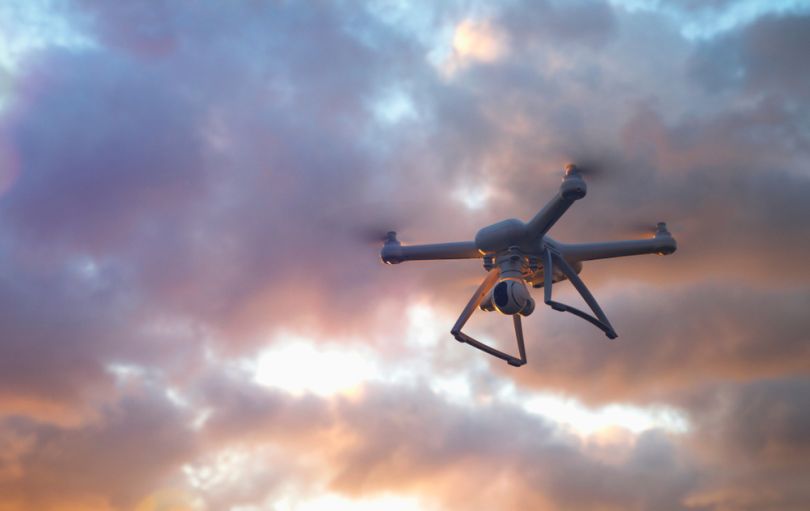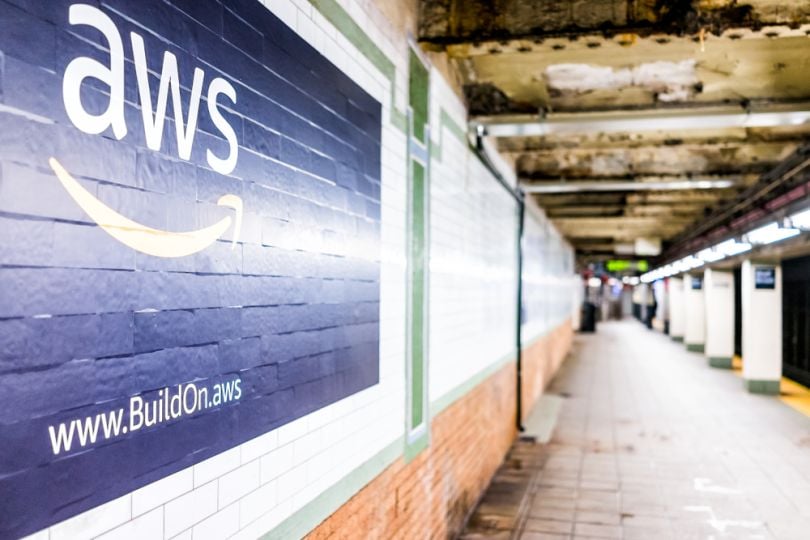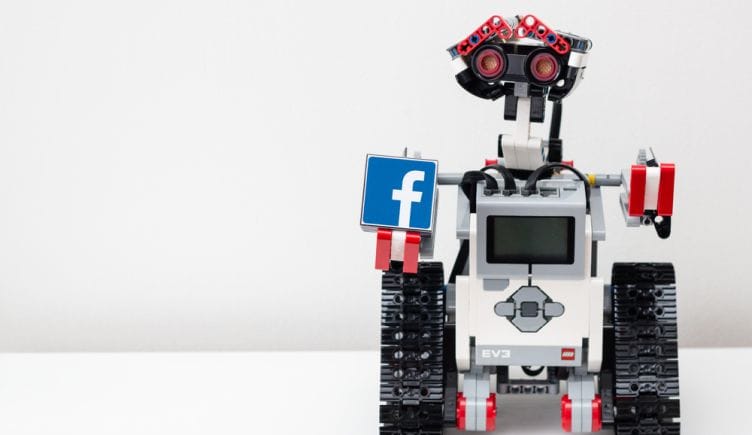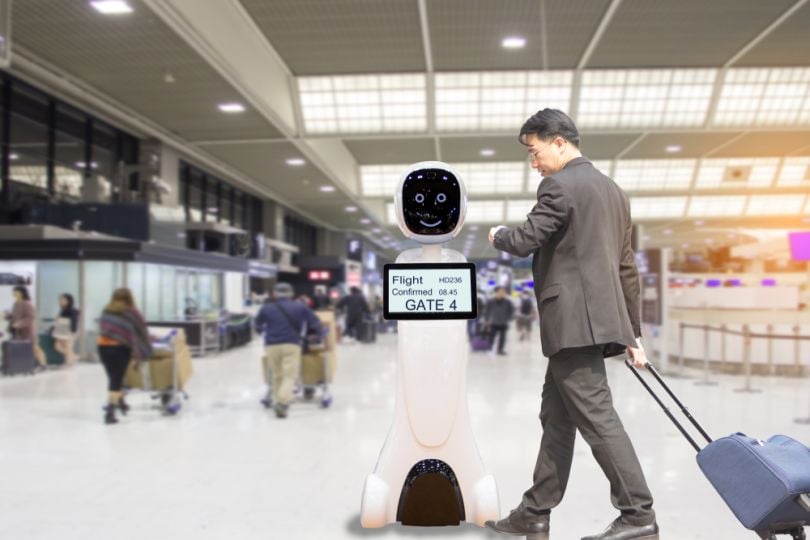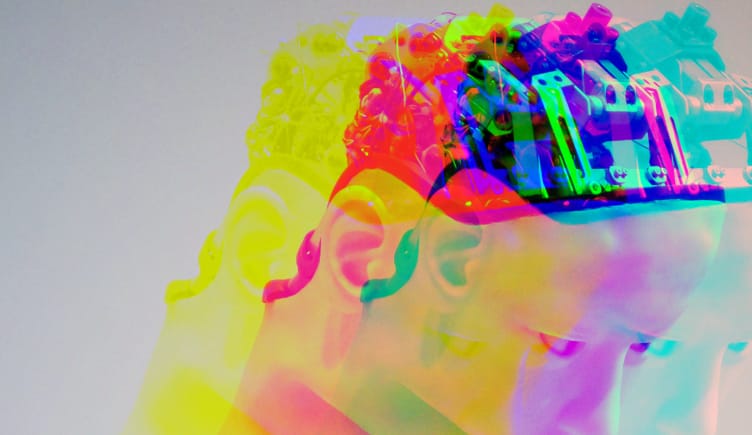 Image: Shutterstock / Built In
Image: Shutterstock / Built In
Pop culture is perhaps the main culprit for the public’s warped perception of the future of robotics. Although figures like C3PO in Star Wars, Data in Star Trek and the cyborg in The Terminator have given robotics some flashy mainstream appeal, they have also established narrow expectations for what robots could be and accomplish in the future.
“I’m never going to rule stuff out,” said Blake Hannaford, robotics professor at the University of Washington in Seattle. “But if you look back on science fiction from the ’50s and ’60s and compare it to today, it really missed the mark.”
For better or for worse, robots have defied human expectations. It’s unlikely that we’ll have to beware of Schwarzenegger-esque killer robots anytime soon, but even so, the future of robotics is sure to have surprises in store.
More on Robotics35 Robotics Companies on the Forefront of Innovation
What Is Robotics?
First, let’s cover some of the basics. Robotics is the practice of designing and manufacturing robots, which perform physical tasks for humans and may possess some degree of autonomy. The field is interdisciplinary by nature, connecting to areas like engineering, computer science and artificial intelligence.
While robots on the big screen often demonstrate human traits, the robotics field encompasses everything from humanoid machines to robotic arms that operate in an assembly line. Robots are already assisting humans in completing major surgeries, rescue operations and climate explorations. While robots fulfill wide-ranging roles, there are certain characteristics that link them under the same umbrella.
What Are Robots?
A robot is a machine that performs tasks typically completed by humans. Different robots come with varying degrees of automation, but each should be able to complete a certain set of tasks on its own. Here are a few basic traits common to all robots:
- Robots display a physical form made of mechanical parts.
- All robots require an electric current — whether from batteries or built-in circuitry — to power their movements and decisions.
- Each robot is guided by programming software and rules that allow them to complete actions and sometimes make decisions on its own.
Contrary to people’s tendency to paint robots in a human light, it’s a degree of inhumanness that defines robots. The ways robots fall short of or surpass human abilities will shape the future of human-robot relationships, and that future proves to be complex with both compelling and cautious undertones as robot types proliferate.
Types of Robots
The robotics ecosystem undergoes constant change, but there are still types of robots that appear most often. Below are the main categories that robots fall under, covering everything from chatbots to humanoids.
Pre-Programmed Robots
Pre-programmed robots are given commands beforehand and cannot change their behavior while performing an action. These types of robots are ideal for completing a single, repetitive task.
Humanoid Robots
Humanoid robots exhibit human-like physical features and even facial expressions. Their human resemblance makes them a good fit for service jobs that require face-to-face human interaction.
Autonomous Robots
Autonomous robots can perform actions and make decisions without human intervention. These robots depend on complex computers to perceive and analyze their surroundings.
Teleoperated Robots
Teleoperated robots are remotely controlled by a human operator through a wireless system like Wi-Fi. They are ideal for performing high-risk actions in extreme environments.
Augmenting Robots
Augmenting robots combine with the human body to supplement a current ability or replace a lost ability. Examples like prosthetic legs have improved people’s quality of life.
Software Bots
Software bots are computer applications that rely on pieces of code to complete actions on their own. Because these bots only exist in online or computer forms, they aren’t considered robots.
Advantages and Disadvantages of Robots
The dialogue surrounding robots is complicated, evoking both hope and fear from different parties. While there is no doubt that robotics is forever changing society, the impact on humans remains uncertain in light of the benefits and consequences that robots present.
Advantages of Robots
There are many reasons to have an optimistic view on robots, including more advancements in other fields and opportunities for humans to perform more interesting, highly-skilled jobs.
Increased Innovation
Robotics often leads to breakthroughs in other fields because of its interdisciplinary nature. Computing power is necessary to fuel robots, and its growth has led to improvements in various technologies. For example, a smartphone can last longer and perform more tasks with the same battery life as its predecessors. More efficient computing power has also helped computer vision and natural language processing make great strides with the goal of enabling robots to better compile and learn from visual data.
As companies push for more intelligent robots, developers will need to create more advanced software to meet these demands as well. The interconnectedness of robotics encourages many fields to move beyond the limits of current knowledge.
Complementary Support
While some workers view robots as replacements, many workers are finding robots to be excellent complements in their work environments. Collaborative robots, also known as cobots, have stepped up to handle repetitive, mundane job duties that require little intellectual exercise from an average human being. In the finance industry, cobots conduct audits and detect fraud, allowing employees to reallocate more time and energy toward complex projects.
By supporting their employees and customers with robots, companies can enjoy higher productivity levels and profits.
New Job Opportunities
It’s true that the introduction of robots will alter the job landscape, but the disappearance of some roles also makes room for higher-level jobs. For every worker replaced by a robot, companies still need to hire software developers and other tech professionals who know how to maintain robotics technology. In this sense, one could argue that robots have overtaken boring jobs and have paved the way for more improved jobs.
For companies suffering from a shortage of workers, robotics also provides a golden opportunity to upgrade their operations. Businesses can team up with robots to automate tasks, introduce employees to new technologies and give them more time to rest and apply their energies accordingly.
Disadvantages of Robots
Robotics has and will continue to change how people live and work, and not all of these changes are beneficial — which is why realistic concerns have been raised.
Privacy and Security Issues
Deciding where to draw boundaries has been a point of contention with robots. AI and robotics come with a range of potential security threats, such as performing surveillance, carrying out social engineering schemes and even committing physical attacks.
Another nightmare scenario for political and business leaders would be an accident involving a robot, such as a drone colliding with an airplane. While these are examples of worst-case events, the industry may need more regulations to ensure robots are applied in a safe and ethical manner.
Unfamiliar Technologies
Robots may lead to a higher demand for tech-based roles to maintain this technology, but not all employees have the skills needed for these jobs. Besides in-depth training, a four-year computer science degree comes with a certain level of prestige that no amount of upskilling may be able to match. As a result, current employees who can’t afford college may get left behind in the wake of a robot revolution.
Job Competition
The automation capabilities of robots mean many workers are likely to be replaced by AI and robotics technologies. In fact, it’s expected that machines will disrupt 85 million jobs by 2025 as workforces resemble more of a human-machine hybrid. And within these hybrid settings, humans may struggle to keep pace with their robot counterparts.
A combination of expanding technologies and a lack of tech talent could hint at a brutal job market for many workers. As AI and robots encroach into areas where humans perform manual labor, workers will need to broaden their skill sets and keep themselves marketable in a job ecosystem shaped by more high-tech roles.
Advancements in Artificial Intelligence and the Future of Robotics
AI is reshaping robotics and creating even more possibilities for how humans and robots interact with each other. Here’s how.
Digital Twins
Engineers already use digital twins to simulate the behavior of robots, refine robotic designs to maximize performance and even control robots from a distance. But AI takes these capabilities to another level, providing alerts for predictive equipment maintenance and simulating entire processes to find more efficient workflows.
Because AI-powered digital twins can compile and analyze large amounts of data, they’re also ideal for revealing customer trends, pinpointing anomalies and providing other big-picture insights.
Robotic Automation
The development of artificial intelligence has led to increasing robotic automation. This has benefited service robots that perform simple tasks and hold basic conversations, as well as drones that are able to fly on their own to gather aerial data for construction sites, monitor crops for farmers and deliver packages for food companies.
Smart Cities
Visions for sustainable smart cities often include AI and robots working together. For example, Seoul has used robotics equipped with AI to provide care to the elderly and assist in classroom education for youth. The two also have a role to play in leading waste management efforts in urban environments: AI-powered robots can quickly transport and organize waste, enabling cities to maintain cleaner spaces while reusing as many resources as possible.
Generative AI
Many robots are able to complete requests based on pre-programmed guidelines, basic controls and speech recognition technology. But ChatGPT and the innovation it sparked in the generative AI space could spill over into robotics, bringing upgrades to robots’ language models.
Microsoft is working to implement ChatGPT into robots, allowing users to initiate interactions with robots through verbal statements. While this technology is still in development, robots infused with generative AI hint at a world where robots can understand and respond to human language to deliver faster results.
The Future of Robotics
At companies and universities around the world, engineers and computer scientists are devising ways to make robots more perceptive and dextrous.
The robotics industry worldwide keeps innovating, combining artificial intelligence and computer vision and other sensory technologies, according to Analytics Insight magazine. The magazine noted that newer iterations of robots are easier to set up and program than their predecessors. Some notable developments in recent years include high-tech ocean robots that explore the world underneath the waves; a robot named Saul that shoots UV rays at the Ebola virus to destroy it; and an AI-controlled therapeutic robot that helps caregivers and patients communicate more efficiently, which reduces stress.
Robots are becoming more human-like in cognitive ability and, in some cases, appearance. In warehouses and factories, at fast food joints and clothing retailers, they’re already working alongside humans. This one, in Germany, can pick like a champ. They’re even starting to perform functions that have typically been the domain of humans, such as making coffee, caring for the elderly and, crucially, ferrying toilet paper. Robots have even made their way into the agriculture and biomedical sectors, harvesting crops, treating diseases and performing other essential tasks. But no matter which sector they serve, robots are far less advanced than many thought they’d be by now.
Will Robots Steal Your Job?
Going forward, Hannaford said, robots will “free up people’s brains” to perform other, more complex tasks. But just as the industrial revolution displaced countless humans who performed manual labor, the robotics revolution won’t happen — and isn’t happening — “without pain and fear and disruption.”
“There’s going to be a lot of people who fall by the wayside,” he said of the countless jobs that will be automated or disappear entirely.
Almost 50 percent of workers who retain their roles through 2025 in the wake of automation will need some form of retraining. Those who do acquire the proper skills will be primed to fill one of the 97 million new roles technologies like robotics and AI are expected to create.
In a warehouse setting, for example, those who transition to other tasks that require “higher skills” such as thinking and complex movement are far less at risk of getting robo-bumped. And they will get bumped. Vince Martinelli, former head of product and marketing at RightHand Robotics, is confident that simple but prevalent jobs like warehouse order picking will largely be done by robots in 10 to 20 years. Right now, though, the technology just isn’t there.
But some experts say the more robots outperform humans, the more humans will be expected to keep up.
“As we start to compare the speed and efficiency of humans to robots, there is a whole new set of health and safety issues that emerge,” Beth Gutelius, associate director of the Center for Urban Economic Development at the University of Illinois–Chicago, told the New York Times.
That’s another argument for retraining. As authors Marcus Casey and Sarah Nzau noted in a Brookings Institution blog post:
“The development of technologies that facilitate new tasks, for which humans are better suited, could potentially lead to a much better future for workers. While the widespread introduction of computers into offices certainly displaced millions of secretaries and typists, the new tasks in associated industries meant new occupations, including computer technicians, software developers and IT consultants.”
Soft Robotics Gains Steam
Researchers in a newish niche called “soft robotics” are working on mimicking human motion. Developing high-performing robotic brains is incredibly difficult. Getting robots to physically react like people do is even harder, as mechanical engineer Christoph Keplinger explained during a 2018 TED Talk.
“The human body makes extensive use of soft and deformable materials such as muscle and skin,” he said. “We need a new generation of robot bodies that is inspired by the elegance, efficiency and by the soft materials of the designs found in nature.”
In describing his efforts to build artificial muscles called “soft activators,” Keplinger calls biological muscle “a true masterpiece of evolution” that can heal after being damaged and is “tightly integrated with sensory neurons for feedback on motion and the environment.”
To that end, he and his team in Boulder, Colorado, invented something they dubbed HASEL — hydraulically amplified self-healing electrostatic actuators, which are mechanisms that control movement. Besides expanding and contracting like real muscle, the young technology can be operated more quickly. In addition, HASEL can be adjusted to deliver larger forces for moving heavy objects, dialed down for more precise movement, and programmed to “deliver very fluidic muscle-like movement and bursts of power to shoot up a ball into the air.”
Besides being compatible with large-scale manufacturing applications, he noted, HASEL technology also could be used to “improve the quality of life” for those who need prosthetic limbs, as well as older people who would benefit from enhanced agility and dexterity.
“Maybe we can call it robotics for anti-aging,” Keplinger said, “or even a next stage of human evolution.”
Researchers have since turned to creatures like jellyfish for further inspiration on how to design soft robots. This out-of-the-box thinking has led to promising results, spurring the development of soft robots that can grip objects with the proper amount of force.
The niche is still young, but many sectors believe it holds a wealth of potential. Supporting NASA-led Mars expeditions and assisting physicians during surgeries are a few of the tasks soft robots may be expected to complete in the near future.
The Rise of Humanoid Robots
Outside of a factory or warehouse setting, some say it’s advantageous for robots to look more like humans. That’s where humanoids come in.
Over at RightHand Robotics, Martinelli said the current focus is on wider customer adoption of robots that can solve specific problems in commercial settings. Even some very impressive and sensor-packed models that can run, jump and flip — including several from Boston Dynamics — aren’t in that category. Not yet, anyway.
Boston Dynamics CEO Marc Raibert has said his long-term goal is to “build robots that have the functional levels of performance that are equal to or greater than people and animals. I don’t mean that they have to work the way that people and animals work, or that they have to look like them, just at the level of performance in terms of the ability to move around in the world, the ability to use our hands.”
The success of the company’s robot dog Spot as an industrial worker has breathed new life into the humanoid space and elevated efforts to fashion humanoids into service helpers. But behind-the-scenes labor isn’t the only area where humanoid robots could make an impact.
As Will Jackson, director at United Kingdom-based Engineered Arts, told BBC television, “Humanoid robots are great for entertainment and they’re great for communication. If you want something that interacts with people, the best way to do that is make something person-shaped.”
Like this invention from Agility Robotics. Dubbed “Digit” and reportedly priced in the low-to-mid six figures, it’s intended for vehicle-to-door delivery of packages weighing 40 pounds or less. Could we see armies of these things in the years ahead? Maybe. Digit hasn’t yet been tested in uncontrolled settings. And if viral YouTube videos are any indication, even a controlled environment is no guarantee of success.
“One of the biggest problems we have is there is nothing as good as human muscle,” Jackson explained. “We don’t come anywhere near to what a human can do. The way you will see humanoid robots is in a commercial context. So you might go into a shop and you might see a robot in there that’s trying to sell you something. Don’t worry about all the clever AI. That’s really going to stay on your computer. It’s not going to chase you up the stairs anytime soon.”
Impact of AI and Robotics on Different Industries
Artificial intelligence and robotics have wide-reaching consequences for society, but the following industries have been especially impacted by these technologies.
Manufacturing
Robots along the assembly line produce goods with a quality and consistency unmatched by human workers. With the addition of AI, organizations can now rely on these machines to operate independently and even oversee their own predictive maintenance reporting. Human workers can then leave repetitive tasks to robots and focus on more complex business needs.
Healthcare
Besides social and care robots, the healthcare industry depends on medical robots equipped with AI to aid in surgeries, power exoskeletons and guide patients through physical therapy and recovery. AI-based robots can also help doctors make more accurate diagnoses, reducing the time it takes to deliver personalized treatment to patients.
Logistics
Warehouses and logistics organizations have employed AI and robotics for heavy-lifting work. Robots can move products around warehouses, stack shelves and perform other manual labor to relieve human workforces of physical wear and tear. Companies are even entrusting AI robots like drones to make short deliveries, bringing down wait times and delays.
Customer Service
Chatbots and virtual assistants have become commonplace for online customers, but AI and robotics are beginning to handle in-person customer interactions as well. Humanoid and non-humanoid robots conduct face-to-face conversations with customers, retrieving products, answering questions and performing other small tasks to make shoppers feel welcome.
Hospitality
Restaurants have come to rely on robots to help with cooking and cleaning needs in the kitchen, and robots can also deliver food to waiting customers. Within the retail space, AI-powered robots can compile insights on customer behaviors in stores to determine the best ways to arrange products and ensure a smoother shopping experience.
Travel
Hotels, resorts and other travel hubs are supporting travelers with AI-driven robots that act as concierges, front-desk help, butlers, guides and other essential personnel. Airports are also using security robots to enforce airline rules, such as detecting passengers with weapons or any illegal items not allowed on flights.
Aerospace
Robotics and artificial intelligence have come to the aid of astronauts, paving the way for space exploration in places like Mars. Martian robots already have the capacity to venture into environments not suitable for humans. The addition of AI allows these robots to operate autonomously, making it easier for groups like NASA to sustain their space exploration efforts.
Energy
Similar to space exploration, the search for plentiful resources has led many companies in the energy sector to embrace AI and robotics. Robots can assist in mapping out the ocean floor and locating high concentrations of natural gas. On land, robots are also tasked with overseeing grid maintenance and fixing wind turbines and other structures.
Education
While robots can’t replace human teachers, they can supplement them in various ways. Leveraging AI, robots can lead one-on-one and small group sessions to help students gain a better grasp of the material. Robots with human features can encourage younger students to exercise and strengthen their social skills as well.
Lifestyle
Smart homes bring AI and robotics into the lives of consumers, simplifying chores with inventions like the robotic kitchen and the roomba vacuum. On a larger scale, smart cities are giving robots the responsibility of areas like waste management and pipe maintenance to keep public spaces healthy.
What Does All This Mean for Humans?
The rise of AI and robotics is bound to forever alter society, generating both excitement and uncertainty.
Robotics and artificial intelligence can streamline everyday chores in the home, improve operations in workplaces and contribute to efforts to make cities and public spaces more sustainable. While robots may take on a greater role in society, they may also merely supplement the work that human professionals do. In this way, robots can serve as partners in building a more efficient and safer environment alongside humans.
At the same time, AI and robots present other problems that need to be resolved. There’s no doubt that some jobs will be lost to automation, and issues around data privacy and rapidly evolving technologies leave many people vulnerable.
Arguments for and against these technologies are valid, but they don’t change the fact that AI and robotics are here to stay. While it still remains to be seen whether these technologies will have a positive or negative impact on humanity, the one certainty is that humans must adjust to a world where robots and AI are a regular part of everyday life.
Frequently Asked Questions
How is AI changing robotics?
AI is enhancing many capabilities of robots, spurring advancements in automated machines, drone technology and the use of generative AI in robotics.
How will the future of robotics impact humans?
Robots contribute to a future where processes in homes, workplaces and public spaces become safer and more efficient. At the same time, job losses due to automation and security risks are major concerns tied to AI and robotics. The overall positive or negative effect of robotics on humans remains to be seen.
If the website content violates your rights, please contact us to delete it。



